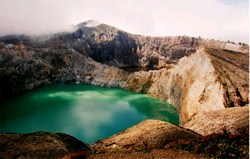Kelimutu Lakes: Flores, East Nusa Tenggara
 Located some 60 kilometers to the east of Ende, Flores, East Nusa Tenggara, there are three lakes of three different colours that are collectively known as the Kelimutu Lakes. To get to the lakes, tourists must travel about two hours overland from Ende to the parking area of Kelimutu National Park and from there walk for about 30 minutes through casuarina trees to reach the crater. Scientists continue to puzzle over the colors of the lakes, which are situated about 1,690 meters above sea level, because they change over time. Before 2006, the lakes were red, blue and white. Now, the red lake is black-brown, the blue lake is light green and the white lake is black. The black-brown lake and the light green lake are located side-by-side, separated only by a wall of earth that is 100-200 centimeters thick.
Located some 60 kilometers to the east of Ende, Flores, East Nusa Tenggara, there are three lakes of three different colours that are collectively known as the Kelimutu Lakes. To get to the lakes, tourists must travel about two hours overland from Ende to the parking area of Kelimutu National Park and from there walk for about 30 minutes through casuarina trees to reach the crater. Scientists continue to puzzle over the colors of the lakes, which are situated about 1,690 meters above sea level, because they change over time. Before 2006, the lakes were red, blue and white. Now, the red lake is black-brown, the blue lake is light green and the white lake is black. The black-brown lake and the light green lake are located side-by-side, separated only by a wall of earth that is 100-200 centimeters thick.
Locals believe the light green lake is a gathering place for the spirits of young men and women (tiwu nua murifai); the black-brown lake, for evil sprits (tiwu ata polo); and the black lake, which is located some 200 meters away, for the spirits of old people (tiwu ata mbupu) according to Yemris Fointuna.
When I arrived at the lakes at 6:30 a.m. in the last week of February, the view of the black lake was obscured by a mist that did not disappear until almost 45 minutes later.
Is it the mineral content of the lakes’ standing waters that is responsible for their color? Or is it their algae content? Scientists have yet to draw a conclusion.
The Kelimutu Lakes were discovered by Van Such Telen, a Dutchman, in 1915, although locals may have known about them earlier.
On Feb. 26, 1992, the government declared the Kelimutu area — measuring 1,051,000 square meters — a national park.
Locals believe Mount Kelimutu is haunted by ghosts who are friendly if they are left undisturbed and it is customary for them to make offerings at a location called Perikonde, the gateway for the spirits wishing to go to Kelimutu.
To fully enjoy the mountain in all its beauty, tourists, visitors and researchers must work hard to get to the top of the mountain before 9 a.m., because from early to late afternoon, mist will once again obscure the view.
I left from Ende at about 3:30 a.m. in a car chartered for Rp 500,000. However, there is another option: you can spend the night in Kampung Moni, which is located about three kilometers away from the Kelimutu Lakes.
In this village, you can stay in wooden huts that are managed by the local administration. The cost is about Rp 100,000 a night. Alternatively, if you are on a limited budget but would like to spend a few days in Kelimutu, you can stay in a homestay for Rp 50,000-75,000 a night.
Tourists can also enjoy the beautiful maiden forests of pine, fir, redwood and edeilweiss.
In Kelimutu, locals sell traditional snacks and main meals, with beef, bananas and corn featuring heavily on the menu. At night, a glass of moke, an alcoholic beverage created from the sap of the palm tree, warms the cockles of the heart.
Ende souvenirs include woven fabrics bearing motifs that are peculiar to the district. Prices range from 40,000 for a scarf to 300,000 for a sarong.
Souvenir seller Sisilia Sita, 53, said tourist numbers peaked between April and October. The mother of three also sells snacks and coffee in the parking area.